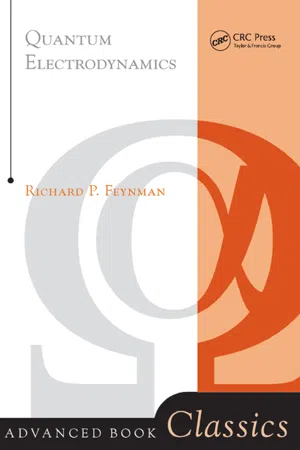
This is a test
- 212 pages
- English
- ePUB (mobile friendly)
- Available on iOS & Android
eBook - ePub
Quantum Electrodynamics
Book details
Book preview
Table of contents
Citations
About This Book
This text material constitutes notes on the third of a three-semester course in quantum mechanics given at the California Institute of Technology in 1953, presenting the main results and calculational procedures of quantum electrodynamics.
Frequently asked questions
At the moment all of our mobile-responsive ePub books are available to download via the app. Most of our PDFs are also available to download and we're working on making the final remaining ones downloadable now. Learn more here.
Both plans give you full access to the library and all of Perlego’s features. The only differences are the price and subscription period: With the annual plan you’ll save around 30% compared to 12 months on the monthly plan.
We are an online textbook subscription service, where you can get access to an entire online library for less than the price of a single book per month. With over 1 million books across 1000+ topics, we’ve got you covered! Learn more here.
Look out for the read-aloud symbol on your next book to see if you can listen to it. The read-aloud tool reads text aloud for you, highlighting the text as it is being read. You can pause it, speed it up and slow it down. Learn more here.
Yes, you can access Quantum Electrodynamics by Richard P. Feynman in PDF and/or ePUB format, as well as other popular books in Physical Sciences & Physics. We have over one million books available in our catalogue for you to explore.
Pauli Principle and the Dirac Equation
In Lecture 24 the probability of a vacuum remaining a vacuum under the influence of a potential was calculated. The potential can create and annihilate pairs (a closed-loop process) between times t1 and t2. The amplitude for the creation and annihilation of one pair is (to first nonvanishing order)
The amplitude for the creation and annihilation for two pairs is a factor L for each, but, to avoid counting each twice when integrating over all dτ1 and dτ2, it is L2/2. For three pairs the amplitude is L3/3!. The total amplitude for a vacuum to remain a vacuum is, then,
(31-7) |

FIG. 31-4
where the 1 comes from the amplitude to remain a vacuum with nothing happening. The use of minus signs for the amplitude for an odd number of pairs can be given the following justification in terms of the Pauli principle. Suppose the diagram for t < t1 is as shown in Fig. 31-4. The completion of this process can occur in two ways, however (see Fig. 31-5). The second way can be thought of as obtained by the interchange of the two electrons, hence the amplitude of the second must be subtracted from that of the first, according to the Pauli principle. But the second process is a one-loop process, whereas the first process is a two-loop process, so it can be concluded that amplitudes for an odd number of loops must be subtracted. The probability for a vacuum to remain a vacuum is

FIG. 31-5
The real part of L (R.P. of L) may be shown to be positive, so it is clear that terms of the series must alternate in sign in order that this probability be not greater than unity.
We have, therefore, two arguments as to why the expression must be e−L. One involves the sign of the real part, a property just of K+ and the Dirac equation. The second involves the Pauli principle. We see, therefore, that it could not be consistent to interpret the Dirac equation as we do unless the electrons obey Fermi-Dirac statistics. There is, therefore, some connection between the relativistic Dirac equation and the exclusion principle. Pauli has given a more elaborate proof of the necessity for the exclusion principle ...
Table of contents
- Cover
- Half Title
- Title Page
- Copyright Page
- Table of Contents
- Editor’s Foreword
- Preface
- Interaction of Light with Matter—Quantum Electrodynamics
- Résumé of the Principles and Results of Special Relativity
- Relativistic Wave Equation
- Solution of the Dirac Equation for a Free Particle
- Potential Problems in Quantum Electrodynamics
- Relativistic Treatment of the Interaction of Particles with Light
- Interaction of Several Electron
- Discussion and Interpretation of Various “Correction” Terms
- Pauli Principle and the Dirac Equation